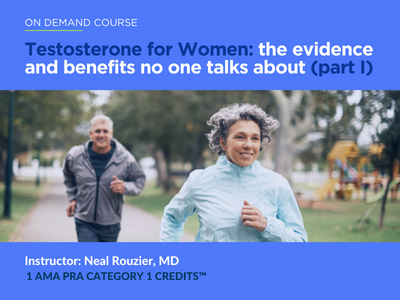
Testosterone for Women: Current AACE Guidelines vs What the Literature Says

Testosterone for Women: Current AACE Guidelines vs What the Literature Says
In Testosterone for Women Part 1: The Evidence and Benefits No One Talks About, I presented the studies/papers demonstrating that symptom improvement is only achieved with supraphysiologic levels of testosterone. Rebecca Glasser, a well-respected and published breast cancer surgeon, proves that symptom improvement is only achieved at total testosterone levels of > 300 ng/ml, with the typical “normal laboratory levels” for women who are not taking testosterone (baseline levels) being < 75 ng/ml for most labs. These measured testosterone levels by Dr. Glasser were trough levels and not peak levels which would have been even higher. Again, there is no recommendation or consensus as to when serum levels should be tested and that will also depend on the type of testosterone used and whether it be in a form of pellet, cream, or injection. What is important is improving a patient’s symptoms and quality of life regardless of serum levels or dosages, which is a difficult concept for some clinicians to grasp. Communicating these concepts, however, can be hard, it requires expertise and the art of medicine when discussing hormone testing and adjustment. The articles that I present in the webinar series should be utilized when it is necessary to provide literature support for what we do and why. There is nothing better than the medical literature support and multiple studies demonstrating the same identical concept, that supraphysiologic levels and dosing are required for symptomatic improvement. Whenever patients or doctors do not understand why we treat to supraphysiologic levels, or do not have the training/expertise/understanding that we teach in the BHRT Workshop Series, I provide them with medical literature and the admonishment of “Here, read this!”
Normal vs Supraphysiologic Dosing
Based on some recent posts on the WLM forum, everyone still wants to know a number, dose, range, goal, etc, despite all of the information discussed in the prior 2 webinars and the BHRT Workshop Series. I still find it amazing that some practitioners want to know optimal levels for a young adult for various labs. They just don’t seem to grasp that numbers are meaningless. In the first study by Rebecca Glasser, she shoots for free testosterone levels that are three times the normal levels for a young adult female in order to achieve symptomatic improvement. So, how does measuring serum levels of testosterone help you if dosage adjustment depends on symptom improvement and never on serum levels? OK, we will look at appropriate dosing and the numbers achieved. Brace yourself, the numbers achieved are very supra-physiologic which goes against some guidelines, normal ranges, opinions, and peer recommendations. However, guidelines that suggest keeping testosterone levels within the normal range ignore the plethora of data demonstrating that symptom improvement in women requires high supraphysiologic levels.
Maintaining TT levels outside the “normal” range makes some PMDs and our peers very uncomfortable. In my honest opinion, any author or expert that recommends that total testosterone levels be “kept and maintained within the normal range” does not have any experience or expertise in prescribing testosterone for women. Realizing that outcome studies demonstrating symptom improvement can be achieved only with supraphysiologic levels, are in stark contrast to some expert opinions where the “expert” authors recommend that testosterone levels must never go above the “normal range.” There is no study that demonstrated maintaining TT levels within the range of “normal” provided any benefit or symptom improvement. If you want to prescribe a dose of testosterone that doesn’t do anything, then use a dose that keeps your measured level within the “normal range.” Any expert or guideline that recommends maintaining testosterone levels within the “normal range” reflects their complete ignorance and rejection of all the scientific literature proving that supraphysiologic administration of testosterone is required for symptomatic improvement. However, knowing and dealing with endocrine society guidelines for 30 years, I have never encountered any guideline that suggests treating outside any normal range. And that applies to all hormones, not just testosterone.
Safety and Efficacy for Testosterone Optimization in Women
In keeping with the theme of testosterone optimization, we will look at more of the data and studies demonstrating the safety and efficacy of supraphysiologic optimization of testosterone in women. In the BHRT Workshop Series, I more than adequately cover the importance of estradiol and progesterone optimization. In last year’s webinar series, I also demonstrated the importance of thyroid optimization with T3 that cannot be achieved with just T4 alone. I then went on to demonstrate that symptomatic improvement cannot be achieved with just T4 alone, nor can it be achieved by adding T3 in small dosages as was done in several biased studies that were designed to fail. I then went on to prove that T3 is needed in supraphysiologic doses and levels in order to achieve maximum improvement in signs and symptoms. Well, testosterone is no different. The expert consensus guidelines and recommendations that I reviewed in the first webinar series on testosterone in women are ludicrous. Their opinion to keep and maintain TT levels within “normal levels and ranges” is not scientific and is without any basis in fact, but not unexpected from AACE which recommend staying inside the box of “normal.” Again, we must keep in mind that guidelines are only opinions, suggestions, recommendations and that all guidelines may be subject to political bias and agendas. A recent paper published in JAMA called society guidelines 20 years out of date and extremely biased in their recommendations. In this webinar we will review evidence based medicine (EBM) examples of RCTs demonstrating improvement of signs and symptoms but only at marked supraphysiologic levels of testosterone. Last month I reviewed Dr. Rebecca Glasser’s publications in “Maturitas.” She provides case examples as to where serum levels need to be for symptom improvement as well as where serum levels are when symptoms recur. Of course, both of these average levels are markedly supraphysiologic, in contrast to the original consensus guidelines that recommend levels be kept within “normal ranges” where symptoms do not improve. Remember that guideline or expert opinion is rated a Grade D for reliability. My recommendations, which are based on multiple outcome studies, are also level D ratings.
Conflicting Research on the use of Testosterone in Women
I find it amazing the number of publications demonstrating improvements in signs and symptoms with supraphysiologic dosing, that are ignored by the authors of the original consensus paper published in JAMA. Their original guidelines are opinions and not EBM. In contrast, my intent is to provide all the pertinent outcome studies demonstrating safety and efficacy of supraphysiologic dosing. Other than a few androgenic side effects that are easily amenable to dosage adjustment and spironolactone, there are no adverse effects seen in any of the studies. The alluding to an increase in cancer is only speculative and not evidence based. The administration of estrogen-alone or testosterone-alone has not been proven to increase the risk of cancer in any study. The difficulty that I have with Dr. Glasser is that she is very anti-estrogen as would be expected from a breast cancer surgeon. She alludes to the fact that testosterone can alleviate the symptoms of estrogen deprivation by stimulating the AR receptor. Well, that’s just great if you don’t mind all the pathology associated with estrogen depletion. Estrogen deprivation increases the risk of CAD, CVD, osteoporosis, Alzheimer’s disease, AMD, dyslipidemia, dysglycemia & DM, and morbidity and mortality from menopause. Just because testosterone can alleviate menopausal symptoms when women take tamoxifen, or an AI, does not mean that it stimulates all estrogen receptors. Leaving a woman estrogen deprived, portends development of the aforementioned problems. Dr. Glasser ignores the studies demonstrating that estrogen administration decreases breast cancer recurrence in breast cancer survivors. Read Bluming’s Book Estrogen Matters.
In Testosterone for Women Part 2: The Evidence and Benefits No One Talks About, I reviewed the 60 RCTs demonstrating that estrogen-alone can safely be given to breast cancer survivors with an added benefit of a decrease in breast cancer recurrence. If estrogen-alone can safely be administered to breast cancer survivors in every study, then why are we worried about testosterone converting into and raising E2 levels via testosterone administration? This is due to our inherent fear that estrogen increases stimulation of estrogen + tumors and therefore there is a need to block estrogen receptors. Although beyond the scope of this presentation, estrogen blocks the recurrence of breast cancer by a different mechanism than tamoxifen and AIs. As per JAMA, the only drug that decreases breast cancer mortality is estrogen, not tamoxifen or AIs. Dr. Glasser recommends the use of testosterone along with an AI (as would all oncologists), whereas I recommend the use of testosterone without the addition of an AI. Dr. Glasser’s recommendation is based on common sense but not on any evidence-based studies. Maintaining women in a state of estrogen deprivation makes no sense nor is it supported by any literature. My recommendation is based on EBM (read Bluming’s book) demonstrating that estrogen decreases breast cancer recurrence in breast cancer survivors. Estrogen also decreases morbidity and all-cause mortality whereas tamoxifen and AIs do not. Moving on.
Reviewing the AACE Guidelines
In this month’s webinar, I will review the endocrine society guidelines for the use of testosterone in women. The guidelines for use of testosterone are very restrictive and do not recommend testosterone use in women for anything other than hypoactive sexual desire disorder. Despite a plethora of data demonstrating significant benefits in the use of testosterone in women, recent AACE guidelines ignore all the EBM literature demonstrating improvement in multiple symptoms as well as protection against heart disease and brain disease like Alzheimer’s disease. So, despite the AACE restrictive use of testosterone in women, their guideline paper published in JCEM reviews multiple studies demonstrating benefits of testosterone that should not be ignored. I will review their guidelines as well as all the literature presented in the AACE guidelines. There is a silver lining in the guidelines demonstrating the many benefits of testosterone in women.
Case Presentation
Your 67 y/o female patient is doing well on your HRT program. Based on a familial history of AD dementia and a personal history of type 2 DM, you have placed her on all the appropriate hormones to protect against the patient developing illness related to IR and old age. The patient has experienced significant improvement in bone density seen on DEXA scan. In addition, she has demonstrated improvement in ability to exercise and maintain a normal body weight and BMI. The patient is well-aware of the risk of AD and that the testosterone she is receiving has demonstrated benefit in protecting against AD and vascular dementia. She remains energetic and still works full-time in real estate. Unfortunately, her PMD has discovered that she is taking BHRT and has advised her to get off all hormones due to the increased risk of dementia, heart attacks, and strokes seen with SHRT. She is concerned as her doctor scared her. In response, you provide her with the important medical studies proving lack of harm of testosterone as well as the many health benefits provided by testosterone. All she wanted is your reassurance and you provided her with EBM that her doctor is not aware of. She appreciates your attention to detail and is more than happy to continue her BHRT program despite admonition from her PMD.
Respectfully, Neal
